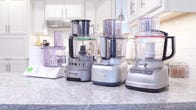For certain kitchen tools and appliances, you can get away with buying a budget version. One of our favorite rice cookers, for instance, costs just $25 and works about as well as much fancier models with precise preset programs and sleek design. When testing for the best blender in 2022, we found that the really cheap machines often performed in line with their price — and it’s quite clearly worth it to drop at least $100 on a blender. That said, we found that spending $350 or more on a Vitamix or Blendtec wasn’t necessarily worth it either.
Different blenders also proved to be more proficient (and less) for various blending jobs. That’s why we broke this list into target categories including the best overall blender for the money, the best smoothie blender, the best small blender, the best premium blender (if money is no issue) and even the best blender for making soup.
In all, we tested 17 popular models over the course of several weeks to find out which models make blending at home a total joy. The following are our picks for the best blenders available in 2022. Be sure to check back since we update our best blender list regularly to include new models, pricing and availability.

 \n ","topic":"","ttag":"","searchDim":"article-body|listicle|image","variant":"article-body|listicle|image","viewguid":"","event":"listicle|image|1","correlationId":"","_destCat":"https:\/\/www.target.com\/p\/nutribullet-blender-1200-watts\/-\/A-54643084#lnk=sametab","productName":"","formatType":"IMAGE","location":"LIST","position":1,"sku":"","dwLinkTag":"article-body|listicle|image","selector":"#article-body #listicle-9059a321-3809-49d6-9c48-68414d98b62d .itemImage"}}” rel=”noopener nofollow” target=”_blank”>
\n ","topic":"","ttag":"","searchDim":"article-body|listicle|image","variant":"article-body|listicle|image","viewguid":"","event":"listicle|image|1","correlationId":"","_destCat":"https:\/\/www.target.com\/p\/nutribullet-blender-1200-watts\/-\/A-54643084#lnk=sametab","productName":"","formatType":"IMAGE","location":"LIST","position":1,"sku":"","dwLinkTag":"article-body|listicle|image","selector":"#article-body #listicle-9059a321-3809-49d6-9c48-68414d98b62d .itemImage"}}” rel=”noopener nofollow” target=”_blank”>
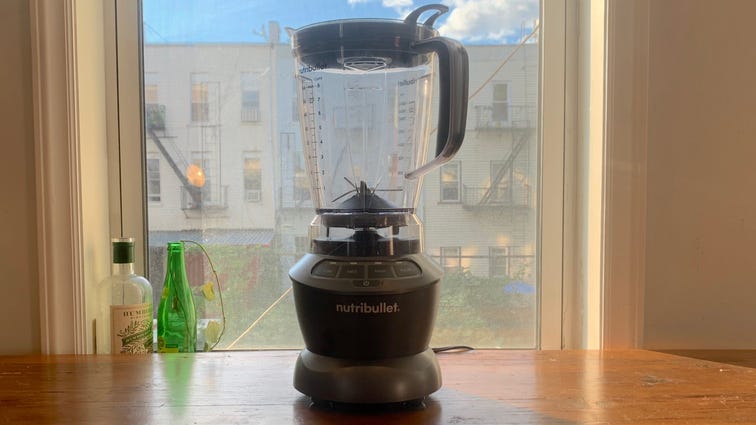

David Watsky/CNET
NutriBullet keeps it simple with three power levels, a pulse setting and 1,200 watts of power. It performed well in all of our tests. Smooth batters, finely crushed ice, green smoothies, hot soup and good grated cheese (our torture test) were all easy to achieve. A reasonable price tag means you won’t have to break the bank to get a good blender.
Slightly more powerful than the comparable Ninja model below, NutriBullet gets the job done quickly. The 64-ounce blending jar is plenty big enough for most recipes. The personal blender comes with a handy recipe book and a tamper to make sure all your ingredients contact the blades. The NutriBullet blender jar is also dishwasher safe and comes with a one-year warranty.
Simple, powerful and consistent, the NutriBullet is one of the best moderately priced blenders on the market right now.

 \n ","topic":"","ttag":"","searchDim":"article-body|listicle|image","variant":"article-body|listicle|image","viewguid":"","event":"listicle|image|2","correlationId":"","_destCat":"https:\/\/www.bestbuy.com\/site\/ninja-twisti-high-speed-blender-duo-platinum\/6498264.p?skuId=6498264&ref=212&loc=1&extStoreId=483&ref=212&loc=1&gclid=Cj0KCQjw-daUBhCIARIsALbkjSa-7Vhz_er8xsRSeRoFeXYgfL0re7Q7KSOxX1iQg5NiqEG4pDlfpo8aAhgZEALw_wcB&gclsrc=aw.ds","productName":"Ninja TWISTi, High-Speed Blender Duo – Platinum","formatType":"IMAGE","location":"LIST","position":2,"sku":"SS151","dwLinkTag":"article-body|listicle|image","selector":"#article-body #listicle-9eb69a5c-fb6f-400a-b37a-a73cc8a8e9fa .itemImage"}}” rel=”noopener nofollow” target=”_blank”>
\n ","topic":"","ttag":"","searchDim":"article-body|listicle|image","variant":"article-body|listicle|image","viewguid":"","event":"listicle|image|2","correlationId":"","_destCat":"https:\/\/www.bestbuy.com\/site\/ninja-twisti-high-speed-blender-duo-platinum\/6498264.p?skuId=6498264&ref=212&loc=1&extStoreId=483&ref=212&loc=1&gclid=Cj0KCQjw-daUBhCIARIsALbkjSa-7Vhz_er8xsRSeRoFeXYgfL0re7Q7KSOxX1iQg5NiqEG4pDlfpo8aAhgZEALw_wcB&gclsrc=aw.ds","productName":"Ninja TWISTi, High-Speed Blender Duo – Platinum","formatType":"IMAGE","location":"LIST","position":2,"sku":"SS151","dwLinkTag":"article-body|listicle|image","selector":"#article-body #listicle-9eb69a5c-fb6f-400a-b37a-a73cc8a8e9fa .itemImage"}}” rel=”noopener nofollow” target=”_blank”>
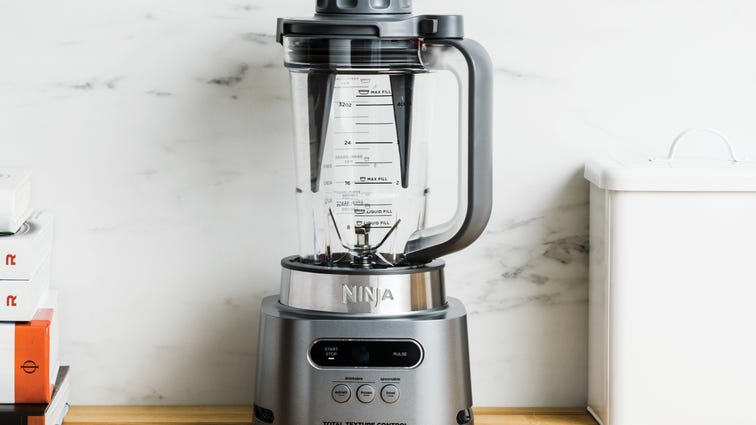

Ninja
If smoothies are the No. 1 reason you pull out the blender, Ninja’s Twisti is the best blender for your buck. This smartly designed, compact model has tamper blades built into the lid that you can twist manually to loosen stuck and stubborn ingredients without having to stop the motor.
In addition to cranking out clump-free smoothies in seconds and without having to stop and scrape, this blender nailed the other tests, including turning nuts into powder and crushing ice in seconds. With 1,600 watts of peak power, there isn’t much this blender can’t pulverize in a snap.
The main reason this unit isn’t atop our list is that it’s small — just 34 ounces — so it won’t be the best pick if you use your blender for making large batches of soups or sauces. But for dip makers and smoothie drinkers who want to save themselves the extra step of having to stop midblend to set dense ingredients free, this blender is your best bet. Read our Ninja Twisti review.

 \n ","topic":"","ttag":"","searchDim":"article-body|listicle|image","variant":"article-body|listicle|image","viewguid":"","event":"listicle|image|3","correlationId":"","_destCat":"https:\/\/www.amazon.com\/Breville-Super-Ounce-Blender-Stainless\/dp\/B07S3XFND1\/","productName":"","formatType":"IMAGE","location":"LIST","position":3,"sku":"","dwLinkTag":"article-body|listicle|image","selector":"#article-body #listicle-83ede075-1024-4637-a051-7b750f392f19 .itemImage"}}” rel=”noopener nofollow” target=”_blank”>
\n ","topic":"","ttag":"","searchDim":"article-body|listicle|image","variant":"article-body|listicle|image","viewguid":"","event":"listicle|image|3","correlationId":"","_destCat":"https:\/\/www.amazon.com\/Breville-Super-Ounce-Blender-Stainless\/dp\/B07S3XFND1\/","productName":"","formatType":"IMAGE","location":"LIST","position":3,"sku":"","dwLinkTag":"article-body|listicle|image","selector":"#article-body #listicle-83ede075-1024-4637-a051-7b750f392f19 .itemImage"}}” rel=”noopener nofollow” target=”_blank”>
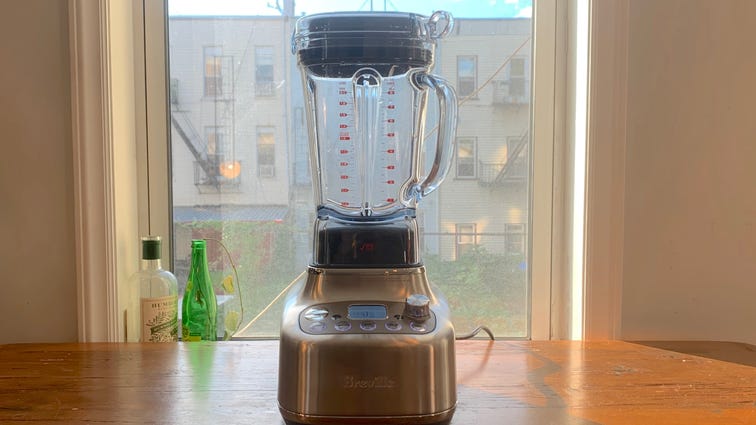

David Watsky/CNET
When you reach a certain level (and price), most blenders do just about everything you need and so you have to start splitting hairs. Vitamix, Blendtec, Hurom, Braun and Cleanblend all make powerful blenders you likely won’t regret buying — but what we love about Breville’s stately Super Q, beyond its performance, are the thoughtful touches. The build and materials used for this blender are sturdy and elegant, and the canister is a different, slightly silkier grade of plastic.
The Super Q also comes with extras — but nothing superfluous. In addition to the 68-ounce canister and 1,800-watt motor base, you get a 24-ounce blending cup with its own separate blade attachment for making single-serve smoothies or soups to take on the go.
As for the tests we ran, the Super Q did as well or better than any of the others. It shredded cheese with ease, pulverized raw almonds to smithereens and made quick and consistent work of ice and a pancake batter mix. The Breville has a few blender settings and programs. Yet since it’s not trying to reinvent the wheel, there aren’t so many that it’ll overwhelm you.
The soup setting (not an official test since most blenders don’t have this preset) worked well, but it doesn’t cook food like the Instant Ace Nova. Because of that, it won’t fully break down veggies and other ingredients and release all those sugars and flavors. In earnest, I’d just as soon make soup in my Dutch oven the old-fashioned way.
This is one of the most expensive blenders we tested, but it was also one of the most pleasurable to use. It also looks great, and if past experience with Breville kitchen appliances is any indicator, it should last you a while.

 \n ","topic":"","ttag":"","searchDim":"article-body|listicle|image","variant":"article-body|listicle|image","viewguid":"","event":"listicle|image|4","correlationId":"","_destCat":"https:\/\/www.amazon.com\/Blender-Smoothies-Shakes-Kitchen-Countertop\/dp\/B093JC4VD2","productName":"","formatType":"IMAGE","location":"LIST","position":4,"sku":"","dwLinkTag":"article-body|listicle|image","selector":"#article-body #listicle-7fb9acc6-d184-4d8c-a2fa-b411fcb17214 .itemImage"}}” rel=”noopener nofollow” target=”_blank”>
\n ","topic":"","ttag":"","searchDim":"article-body|listicle|image","variant":"article-body|listicle|image","viewguid":"","event":"listicle|image|4","correlationId":"","_destCat":"https:\/\/www.amazon.com\/Blender-Smoothies-Shakes-Kitchen-Countertop\/dp\/B093JC4VD2","productName":"","formatType":"IMAGE","location":"LIST","position":4,"sku":"","dwLinkTag":"article-body|listicle|image","selector":"#article-body #listicle-7fb9acc6-d184-4d8c-a2fa-b411fcb17214 .itemImage"}}” rel=”noopener nofollow” target=”_blank”>
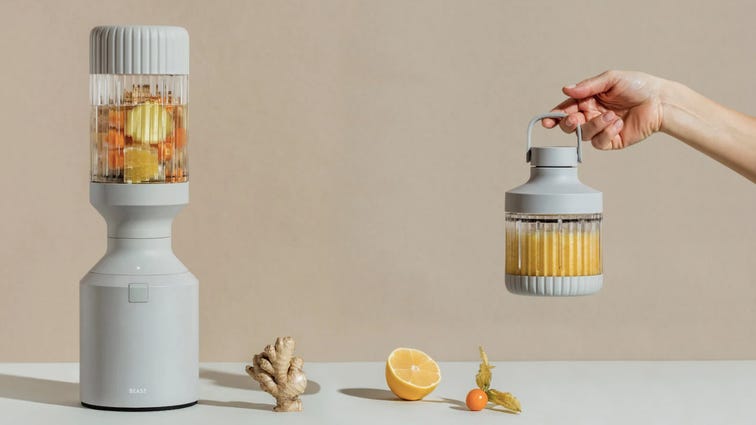

Beast Health
This new entry to the category is my pick for the best small or personal blender. Though it comes from the brains behind the NutriBullet, the brands are not tied anymore.
I love the aesthetic of the Beast. It also happens to be a powerful and fun-to-use personal blender with simple, intuitive controls. In testing, this blender had no trouble crushing ice in seconds, pulverizing nuts and whipping veggies into a puree. It also feels great in your hands, thanks to a silky matte rubber. If you prefer to leave your daily smoothie- or shake-maker out on the counter more than in the cupboard, it’ll definitely attract compliments as it looks and feels expensive. Plus, all the lids screw on securely and double as storage containers to refrigerate your blends afterward.
The Beast is not exactly cheap, but the price — $155 for the blender with drinking and storage caps — is a fair one considering its above-average performance and sleek design. While the NutriBullet RX (that brand’s premium model) retails for $118 on Amazon, I’d personally cough up the extra $40 or so for the Beast B10’s improvements both in style and substance.

 \n ","topic":"","ttag":"","searchDim":"article-body|listicle|image","variant":"article-body|listicle|image","viewguid":"","event":"listicle|image|5","correlationId":"","_destCat":"https:\/\/www.wayfair.com\/kitchen-tabletop\/pdp\/instant-pot-ace-nova-blender-istp1036.html","productName":"","formatType":"IMAGE","location":"LIST","position":5,"sku":"","dwLinkTag":"article-body|listicle|image","selector":"#article-body #listicle-158560e9-737b-4e12-9557-4f36429bf398 .itemImage"}}” rel=”noopener nofollow” target=”_blank”>
\n ","topic":"","ttag":"","searchDim":"article-body|listicle|image","variant":"article-body|listicle|image","viewguid":"","event":"listicle|image|5","correlationId":"","_destCat":"https:\/\/www.wayfair.com\/kitchen-tabletop\/pdp\/instant-pot-ace-nova-blender-istp1036.html","productName":"","formatType":"IMAGE","location":"LIST","position":5,"sku":"","dwLinkTag":"article-body|listicle|image","selector":"#article-body #listicle-158560e9-737b-4e12-9557-4f36429bf398 .itemImage"}}” rel=”noopener nofollow” target=”_blank”>
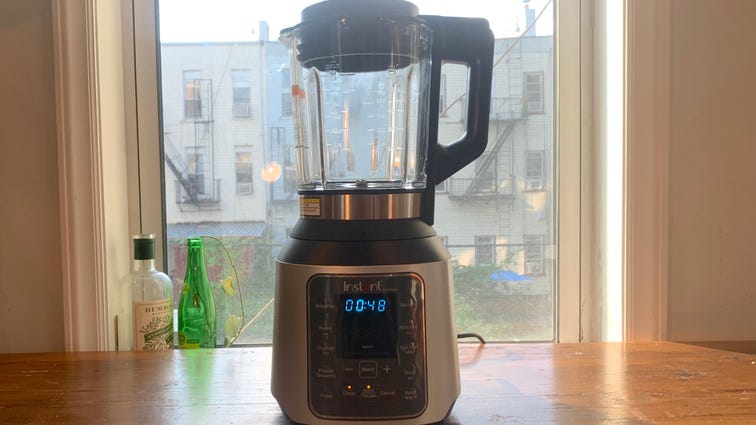

David Watsky/CNET
This is the only blender we tested that has an actual cooking function. While some blenders — including certain Vitamix blender like Vitamix e310 explorian blender, the Braun TriForce and Breville Super Q — use sheer force and friction to heat up a blend, this one generates heat to cook what’s inside and then whirs it all into a pureed soup with one button touch.
To test the soup setting, we threw a bunch of very roughly chopped vegetables, chicken stock, garlic and herbs into the canister, then hit the soup 2 program. Over the next 20 minutes, we watched as it cooked the veggies and spun them into a silky smooth soup. There’s also an option to leave the soup chunky if you prefer. If you’ve used a Thermomix, it’s like a mini version that doesn’t cost $1,500. We found it to be a particularly impressive feature for a blender at this price.
How did it do in the other blending tests? Pretty well, although it is definitely not the most powerful blender we tested. The Instant Ace Nova handled frozen fruit, ice, raw almonds and cheese with little resistance and the cleaning program worked particularly well — perhaps the best of the bunch. The Ace Nova was also one of the quietest of the blenders we tested, which has to count for something.
The one obvious drawback for this blender is its weight. The Instant Ace was one of the heaviest — not something you want to be moving around or lifting too often. That said, its overall size is manageable. And because it’s such a versatile blender, it’s likely to earn a permanent spot on the counter.
Other models we tested
Hurom Hexa Power Speed: If you’re looking for simple functionality and pure power, this is our top pick. The Hurom Hexa doesn’t have many fancy presets and functions (just smoothie, ice crush, soup and pulse) but does have 1,600 watts of power to whip the crap out of anything that you put inside. It almost feels industrial grade and creates a vortex inside akin to something you’d see at a science museum. We also love how this blender looks with its shiny stainless steel armor. Worth noting that it’s the tallest of the blenders we tested so it won’t store as easily as some of the others.
Oster Versa Pro Series: This Oster model is a good performer and includes a few extra features we found helpful. It’s on the expensive side, but this price includes a beverage container and a set of bowls and blades for food processing. You’re almost getting two appliances here, a blender and a food processor. It also has a reverse blend button which is great for crushing ice and making nut flour.
Vitamix Explorian E310: I don’t have much bad to say about the Vitamix Explorian. We used it plenty and loved doing it but it is rather pricey when you get right down to it. That said, there’s a reason Vitamix has a cult-like following and this model will do just about any standard kitchen blending task and then some. Even if we had an extra hundred or more to spend on one of Vitamix’s premium models, we’d still opt for the Explorian. It also includes a great recipe book and custom tamper.
Braun TriForce: This is another blender with loads of brute force and it passed every test we gave it. The issue with Braun’s premium blender is the build and materials which don’t feel commensurate with the price.
Beautiful by Drew Barrymore: We’ve been impressed by other products from this new line of budget-friendly kitchen appliances, including the electric kettle and air fryer. Sadly, the blender did not pass muster. It’s serviceable, to be certain, but didn’t excel in testing and it feels a bit cheap. I’d also worry about the shelf life of its all-digital control panel.
Cuisinart SmartPower SPB-7CH: It’s hard to figure out what happened to this stalwart kitchen brand but this blender model, along with other Cuisinart appliances I’ve tested lately, have been disappointing. That’s especially true when you consider the bloated prices. The digital blender feels cheap and flimsy and netted mediocre results in testing.
KitchenAid K400: This KitchenAid blender is beautiful, but left something to be desired when it came to performance for that price. It has five speeds, pulse and three presets. If you have your heart set on a colorful, quality blender, KitchenAid is a good option.
Vitamix 5200: Variable speed and sturdy design make this Vitamix 5200 blender a popular model for luxury blenders. Though considered a high-performance blender, at such a high price, we weren’t wowed enough to recommend it. It struggled with cheese grating and we found it to be noticeably louder than other models.
Blendtec Total Classic: This popular Blendtec blender worked well with frozen ingredients and crushed ice, making it a good choice for blending smoothies and making frozen cocktails. However, the Blendtec failed to grate cheese and the batter mixing preset was less effective than regular blending by speed.
Hamilton Beach Power Elite: Affordability aside, this blender didn’t perform well enough to recommend. While it did have a nice glass bowl, the lid was infuriatingly hard to remove. It has only presets, so you’ll need to deduce which ones are actually low, medium or high.
Black & Decker Crush Master: This blender will work if you really need something cheap in a pinch. But don’t expect excellence. It wasn’t able to handle large frozen strawberries or evenly mix pancake batter. Still, it could suffice for small jobs.
Breville Fresh & Furious: Great looks and bonus points for a cute name, but that’s not enough to recommend this blender. Performance was average and it struggled to mix wet and dry ingredients.
How we tested the blenders
Testing blenders isn’t just smoothies and ice-crushing. There are a lot of other recipes blenders work well for and these tests highlight how capable each model is when it comes to dry, large and coarse ingredients.
Ice
In a test of pure crushing power, we placed two cups of ice cubes into each blender. Counting the number of pulses it takes to get to fine, crushed ice gives a good indication of real-world chopping power. The three blenders we recommended above performed well.
Smoothie
A classic blender recipe, fruit smoothies were high on my list of recipes to test. This shouldn’t be a big stress test for any decent blender and so it really comes down to speed and consistency. We used two cups of orange juice and one cup of frozen strawberries to make the test smoothies.
While many of these tests yielded very similar results, a few worked faster than others. Not all blenders come with presets, but the ones that do almost always include a smoothie function. When possible, this is the mode we used. If there was no smoothie blender function, we followed the blender’s manual recommendation for smoothie making. This was usually around a minute on high.
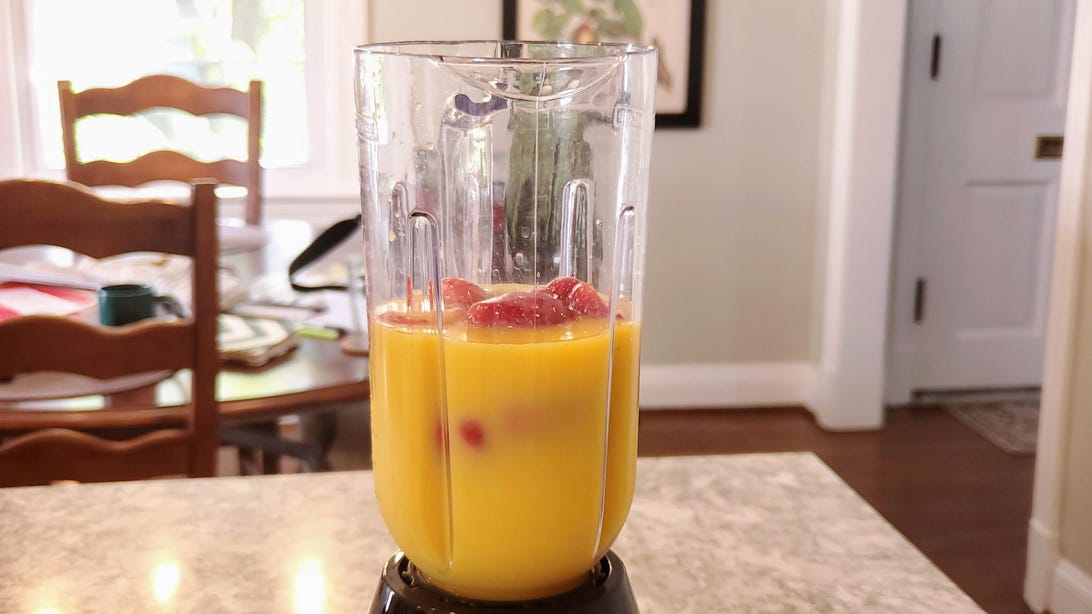

Smoothie testing starts with whole, frozen strawberries and orange juice.
Molly Price/CNETThis is a relatively easy test and most blenders handled frozen ingredients well. Some were frothier and some slushier, but only the Black & Decker model left large chunks of frozen strawberry unblended.
Nut flour and butter
Blenders aren’t all about beverages. There are plenty of other uses, including grinding dry ingredients. For our dry ingredient test, we put a cup of almond pieces (unroasted) in each blender and pulsed until those pieces were reduced to a fine flour. A bit of a challenge for some blenders, but most were able to do this in about 10 to 20 pulses, with the Hamilton Beach model yielding noticeably coarser results.
Nut butter is a different story. Most blenders aren’t really designed for long running times and the level of processing needed to make a butter like almond butter or peanut butter. In fact, many recommend not running the blender for more than a few minutes at a time.
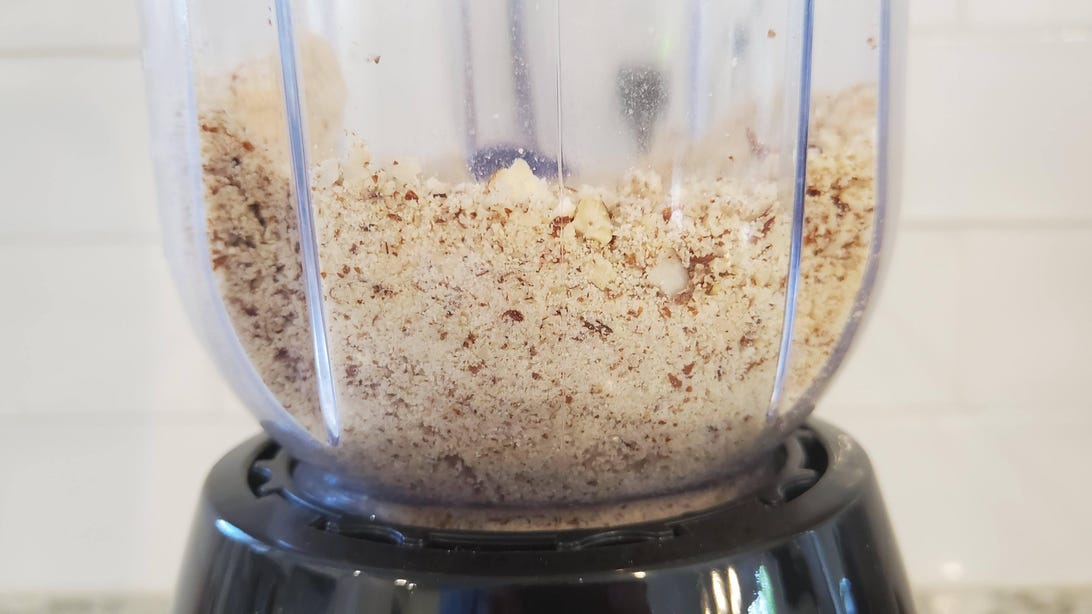

This nut flour is a bit coarse.
Molly Price/CNETOnly one Vitamix model showed real signs of progress toward almond butter in our testing with the nut flour, and it plateaued before achieving a good consistency. Most models simply whirred the dry ingredients upward and into the hard-to-wash crevices of their lids. If you’re set on making nut butters, we recommend a model like the Oster with an included processing kit, or a separate food processor.
Cheese
Did you know blenders can shred cheese? It’s true; some blenders can. We placed an 8-ounce block of cheese in each blender and pulsed until the entire block was shredded. This brought to light a few interesting design choices among some models. The Ninja, for example, lost the cheese round because multiple blender blade levels made it impossible to fit the cheese block in the blender. I had to cut it up into pieces.
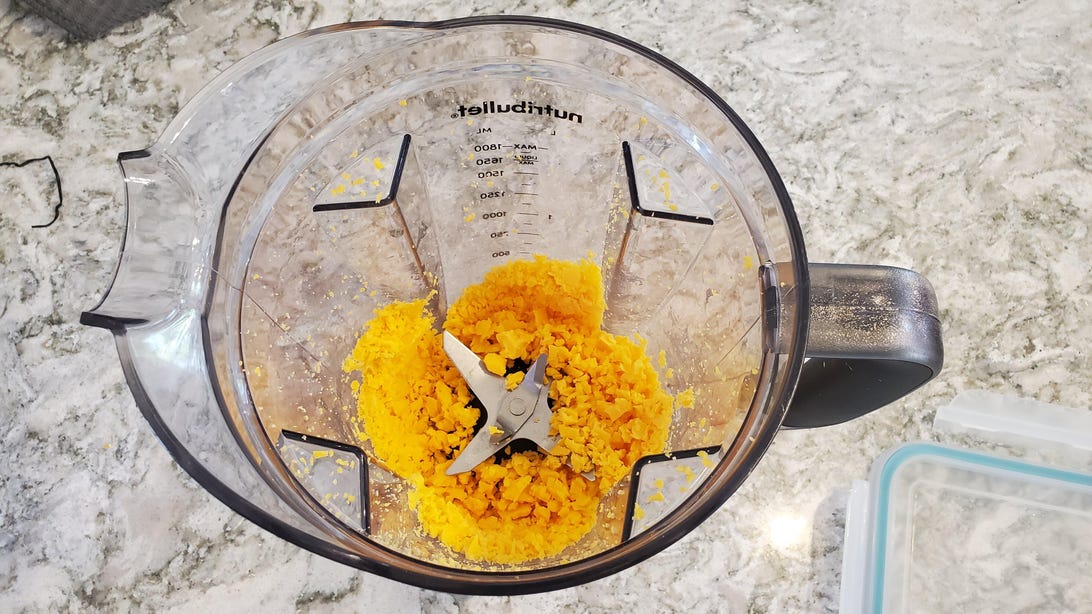

Blenders can shred cheese and this NutriBullet did so in record time; just four pulses.
Molly Price/CNETBoth Vitamix models had some trouble with this particular test and bore holes in the cheese block without actually blending it, simultaneously melting what little cheese had been shredded as the machine heated up. Meanwhile, the NutriBullet, Ninja, instant Pot, Breville Super Q and Hurom Hexa handled grating the cheese block in less than five pulses.
Pancake batter
If you’ve seen our list of the best waffle makers, it should come as no surprise that pancake batter made an appearance in our blender testing. While I was happy to fire up the griddle and flip some cakes, mixing batter is an important test. It measures how easy or difficult it is for the blender to mix wet and dry ingredients.
Blender buying tips
Like most kitchen appliances, you should think about how often you’ll use it, for what tasks and is it a portable blender. Many budget blenders could handle a few smoothies every summer. It’s not worth spending $200 on a blender you’ll use for two occasions each year. If you’re mixing batters, grinding dry ingredients and crushing ice on a regular basis, however, it might be wise to invest in a quality model. Here are a few things to keep in mind.
Accessories
With a conventional blender, accessories can make all the difference. A blender that comes with a tamper is great for getting those last stubborn bits into the blender blades and it’s one item I would highly recommend checking for when you buy a blender. Several models we tested included one in the box. You can purchase them separately, but they’re often model-specific with a ring guard at the top to keep you from plunging the tamper into the blender blades.
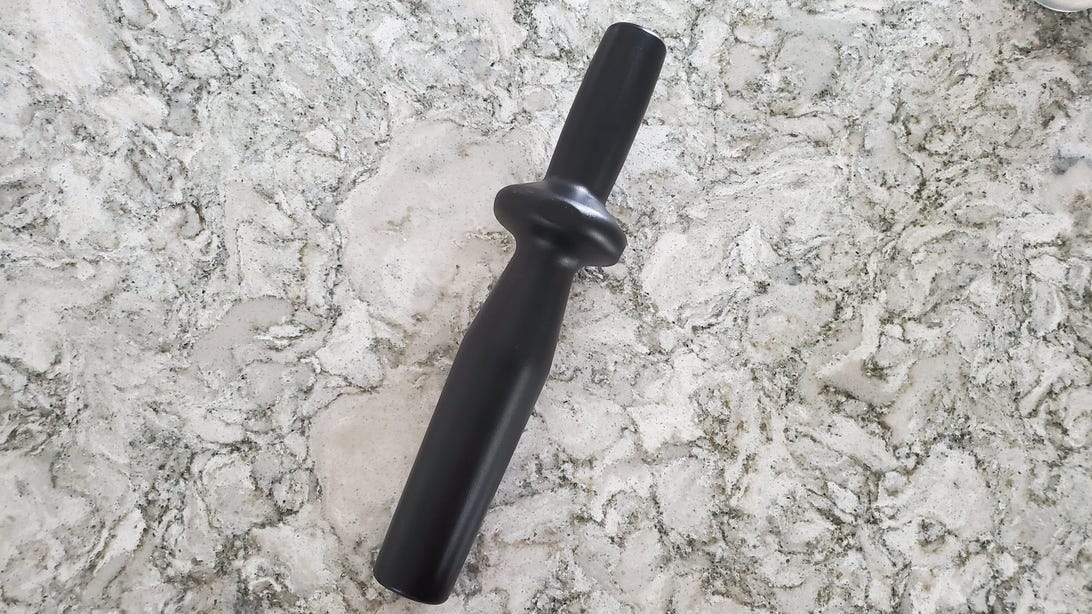

A tamper is included with some blenders and it’s a useful tool for moving ingredients safely toward the blade assembly.
Molly Price/CNETIf you’ll be making smoothies and frozen drinks, a blender with a special set of travel blender cup containers makes getting out the door one step easier. If you’re blending larger, more dense foods for recipes, consider a model that has either a food processing bowl and wheel blade option or something with high-power wattage. Ninja and NutriBullet make these kits for travel containers and processors.
Preset preference
Next, consider your preference for specific modes versus speeds. We found some modes to be effective and helpful, while other blenders worked better when we took over and chose a speed for my ingredients, watching for when to stop. Some models offer simply low, medium and high modes. Others, like many Vitamix models, are variable, with speeds 1 to 10 on a dial. While it comes down to preference, in my opinion, you’ll have more control over your result without a preset. Yes, you’ll need to keep watch and be a bit more hands-on, but it’s easier to be sure things don’t get too blended, overheated or stop before everything is truly mixed.
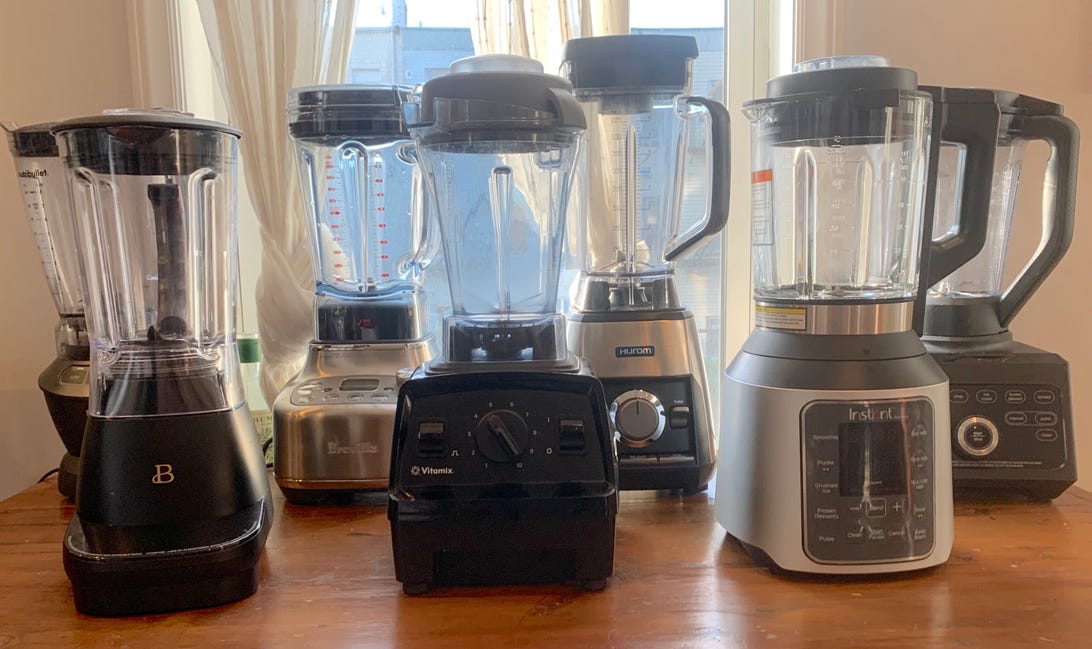

I’d like to see you try to get this many blenders to hold still for a photo.
David Watsky/CNETDesign
Blenders don’t have to be boring. KitchenAid models come in a rainbow of colors. The Oster Versa Pro above looks pretty sporty and the Breville Super Q and Hurom Hexa both had lovely finishes and a sturdy feel. Don’t forget to consider aesthetics if this appliance will live on your countertop.
If your blender will be on your kitchen counter, we recommend measuring the height between your countertop and your upper cabinets. A few models we tested including the Hurom and Breville Super Q may not fit beneath standard cabinets and would inhibit you from sliding it to the back of my counter when not in use.
Best blenders FAQs
What are the different types of blenders?
There are several types of blenders and each is designed for a specific use.
Full-sized blenders: This is the blender you probably imagine when someone says the word “blender.” These are the most versatile of the bunch, but they are also generally the largest, with blending jars as large as 72 ounces. If you do a lot of blending — soups, dips, smoothies, sauces, frozen drinks and nut butter — you’ll want a good full-sized blender. They can be as powerful as 2,000 watts and cost as much as $600, but you can also nab a great one with fewer bells and whistles and less power for $100 or so (see above).
Personal blenders: This term refers to smaller blenders such as NutriBullet, Beast, NutriNinja and others. These blenders have less capacity, around 24 to 32 ounces, give or take. They’re great for soups and smoothies but often have a bit less power — between 900 and 1,000 watts — so they’re not as good for dense ingredients like nuts.
Immersion blenders: These handheld versions of the blender have one main use: to puree a soup or sauce that’s already in a pot. An immersion blender saves you from having to transfer hot liquids from a pot to a blender jar. Though some cost a pretty penny, many serviceable immersion blenders start as low as $30.
Portable blenders: These blenders are so small that you can take them with you on the go. They often run on battery, so you can blend anywhere — the beach, at your desk or after the gym. BlendJet is a popular brand and their teeny-weeny blenders cost around $50.
What is the difference between a blender and a food processor?
While a blender and food processor are similar at first blush, they are used for distinctly different kitchen and cooking jobs. A food processor can’t do the work of a blender, nor can a blender do the work of a food processor: They’re not interchangeable.
Blenders generally have one fixed blade designed to puree or whip ingredients into a liquid or smooth paste. Classic examples are smoothies, soups, sauces and nut butters. Food processors, on the other hand, generally have a set of blades for different tasks — they’re best when they step in for your knife. Most food processors can chop, dice and mince. They can also grate and shred if you need a lot of cheese or are making coleslaw from scratch.
While they won’t do each other’s tasks well, you can buy blenders with food processor attachments, including this $160 Ninja MegaSystem (includes blender) or this $200 Vitamix food processor attachment (does not include blender) that works with Ascent and Venturist models.
How much power should a blender have?
Wattage and horsepower are the two most common ways to measure the sheer capacity of a blender. For small or personal blenders, 1,000 watts of power is all you’ll need given the minimal amount of ingredients you’re blending. For large and full-sized blenders, 1,100 watts is still more than a serviceable amount of power to do most of the daily blending jobs you’ll ask of it. Our top blender picks for the price — the Ninja and the NutriBullet — are both in that 1,100 range. They both performed well and cost much less than a Vitamix or Breville.
Wattage in premium and super-premium blenders can go as high as 2,000, though most are somewhere between 1,400 and 1,800 watts. This amount of power means you’ll likely get a longer life out of the blender since it won’t have to rely on full power to do the easier, daily blending jobs. It also means faster blending since the blades are able to hit higher speeds.
Total horsepower is a sexy (and newer) unit of measurement for blenders, but brands also use it for smoke and mirrors. For more, read about the truth about horsepower in blenders.
